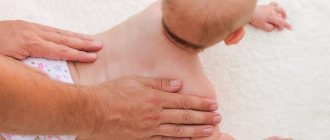It is important!
The benefits of gymnastics are undeniable, but before you start exercising with your baby, you should definitely consult with your pediatrician. During the first weeks after the hospital, he will visit you at home. There are few contraindications against gymnastics for a baby, but they still exist. You should refrain from exercise if the child has skin diseases, problems with the heart and respiratory system, and others. In some cases, a child requires a professional massage, which cannot be replaced by independent gymnastics at home.
What is important to know about a 2 month old baby?
For newborns, the second month of life is very difficult. The baby is not yet accustomed to extrauterine existence. And hypertonicity still persists. But there are also noticeable changes:
- The baby is already beginning to gradually unclench her fingers.
- And while lying on his tummy, he raises his head 15 cm and holds it for half a minute.
- And he spreads his arms to the sides for a short time.
It is important to understand: the main person for the baby is the mother. And therefore it is better if she does gymnastics with the baby.
What time to do gymnastics
Gymnastics should be done daily, 3-5 1-2 sessions per day. Perform exercises at least half an hour before meals or 1 hour after feeding.
Conditions for classes
- Ventilate the room where you will study with your baby. The room should be warm, but not hot. The optimal temperature is 20-21 degrees. During the massage, the child also takes air baths - an important hardening factor.
- Conduct classes on a flat, hard surface: on a changing or regular table, or the lid of a chest of drawers. A bed or sofa is not suitable for these purposes, as it will sag under the child and there will be no effect from the exercises. To make your baby comfortable, place a thin blanket on the tabletop and cover it with a diaper.
- The child should be in a good mood, calm and active. If he wants to sleep, is capricious or unwell, classes should be postponed.
- The mother should also tune in to communicate with the baby, not rush anywhere, and not fuss.
- Gymnastics should be combined with air baths. Undress your baby and remove his diaper. Let nothing hinder his movements.
- While doing the exercises, talk to your baby, recite nursery rhymes, and sing songs. You can turn on soft background music.
Features of exercises for a 2-month-old baby
The benefits of gymnastics for a 2-month-old baby are beyond doubt. But you should not start classes immediately. It is recommended to consult your pediatrician first. The doctor will examine the child and prescribe a complex.
General rules
During the implementation of the complex, it is recommended to follow the recommendations of doctors. They are determined by the developmental characteristics of the baby at 2 months. Before starting the procedures you should:
- Prepare the room. The room should be ventilated. The air temperature should be 22 degrees Celsius. At the same time, drafts are unacceptable.
- Prepare the place. A hard surface (table) with a blanket and a disposable diaper placed on top is suitable.
- Prepare your hands. It is necessary to remove bracelets, watches, rings. Wash your hands and be sure to warm them.
- Before the complex, perform a light warming massage. Movements should be smooth, as sudden movements frighten the baby. Only light stroking and pressing are allowed.
- The basic rule: go from simple to complex. It is recommended to start gymnastics with light exercises. After the baby masters them, you should move on to more difficult ones.
- Before starting gymnastics, you should assess the baby’s condition. If he is sick or simply upset, the complex should not be performed.
- You should start exercising an hour after meals or half an hour before feeding. Total duration: 6 minutes. Together with massage - 20 minutes.
- When performing a massage, it is forbidden to touch the fontanelles, knees, elbows, and inner thighs.
- When carrying out procedures, emotional contact is important. You should talk to the baby kindly.
During the exercises, the baby got tired: after finishing the procedures, he needs to rest.
Exercises for babies up to 2 months
- Place your baby on his back. With both hands, make light stroking movements from the center of the chest to the sides - 3-5 times.
- Stroke the baby's tummy in a clockwise circular motion - without effort, without pressing.
- Let your baby wrap his fist around your finger. Stroke his arms one by one, moving from the hands to the shoulders – 5-6 times. Then gently massage your brushes.
- Stroke your baby's legs 5-6 times from the feet to the hips. Then with your thumb, gently press on the baby’s foot at the base of the toes - the baby will reflexively press them. Maintaining light pressure, move along the foot to the heel. Repeat 5 times for each leg.
- Turn the baby onto his stomach. Stroke his back from head to buttocks with the back of your hand 6-7 times.
- Place your palms on your baby's feet and apply gentle pressure as if pushing them forward. The baby will make reflexive attempts to crawl. The exercise helps strengthen the muscles of the back and abdomen, and trains the legs.
- Turn the child onto his side. Without pressing, move your finger along the spine from top to bottom. The baby will reflexively arch his back and return to his original position. Do the exercise 1-2 times on each side.
When and what to do?
3-8 weeks
.
The main gymnastics at this age is lightly stroking the baby’s arms, legs, head and belly. 2-3 months
.
Add to the stroking a light massage of the baby's palms, feet and fingers. You can turn the baby onto his stomach and stroke his back and shoulders. 4 months
.
Complement the exercise course with an active tummy massage. And also start doing gymnastic exercises with your legs and arms: bending, abducting and adducting them. 6 months
. Start sitting your baby down. Performing supported squats will help train your back and abdominal muscles. In addition, from the age of four months, a baby can begin to actively swim in an “adult” bath. Buy him a special support circle for his neck, as well as a non-slip bath mat.
Exercises for babies 2-6 months
Gymnastics for babies over two months of age should also begin with a light massage. Under no circumstances do we press on the baby’s skin or apply any force. We add more complex exercises to the previous complex:
- After massaging your hands, let your baby hold your thumbs and spread his arms to the sides. Having fixed them in this position for a couple of seconds, cross the baby’s arms over his chest. Repeat the exercise several times, alternating hands: first the right one on top, then the left one.
- After massaging the legs, grab your baby's shins. Perform the “bicycle” exercise: bend your legs one by one, pressing them to your stomach. Then bend both legs at the same time several times.
- Grab your baby's torso under the arms and lift him vertically. Let him touch his feet—not his toes—to a flat surface. He should reflexively step with his legs, as if walking. It is important to keep the baby suspended. The baby should not fully lean on his legs. They, like the baby’s spine, are not yet ready for such loads.
More complex complexes must be discussed with your doctor. Remember, every child is unique, you need to approach classes taking into account the individual characteristics of your baby.
Developing a two month old baby
To develop your hearing, it is useful to turn on music from time to time. Let it be different melodies - cheerful, energetic in the first half of the day and soft, soothing in the evening. Classical music is considered the most favorable music.
Bracelets with bells will be an interesting experience for your child. Place this bracelet on your child's wrist. Watch how he begins to listen to the sound of the bells while moving. If the baby shows dissatisfaction, remove the bracelet.
Do activities with rattles, this is also useful for hearing development. If a 2-month-old baby already knows how to respond to the sound of one rattle, then it’s time to move on to classes with two toys. Rattle one of them, pause for a few seconds, then rattle another rattle on the other side. Wait for the baby's reaction.
A 2-month-old baby will be happy with a toy called a “mobile.” This is a hanging carousel with toys that rotates. Usually installed above a child's crib. Some models rotate when the wind blows or the mother's movements, while others have a built-in rotation mechanism. Mobile phones are also often equipped with melodies that play while the carousel rotates.
The baby will begin to follow the movement of the figures on the mobile and listen to the music. This is a good workout for both vision and hearing. The optimal operating time of the mobile is 5 minutes. If turned on for a longer period of time, the baby will begin to get tired, and his vision will be overloaded.
Exercises to develop tactile sensations will be useful. Place different objects in the baby's palm. For example, a felt-tip pen, a thick thread with a knot at the end, an embossed piece of fabric, etc.
Here's another useful exercise. Sew small bags from brightly colored fabric. Fill them with something, such as beads or cereal. Sew the bags tightly so that the baby cannot get the filling out of them. Let him feel the bags with different fillings. This will enrich his tactile sensations and promote the development of fine motor skills.
conclusions
- Gymnastics strengthens muscles, gives the baby a good appetite, healthy digestion and sound sleep.
- Classes should be carried out half an hour before meals or 1 hour after, in a ventilated room, on a flat, hard surface.
- When working with a newborn, it is enough to make light stroking movements: from the center of the chest to the sides, from the hands to the shoulders, from the feet to the hips, from the neck to the buttocks. The tummy should be stroked in a clockwise circular motion.
- As the baby gets older, you need to add reflex crawling and walking, straightening the back in a side position, and bending the arms and legs to the exercises.
- The technique of performing gymnastics for infants should be agreed upon with a doctor. If you are unsure how to do an exercise, ask a massage nurse to teach you. Unskillful movements can harm the child.
Indications and contraindications
Useful exercises will be harmful if the child is diagnosed with:
- ARVI, acute respiratory infection or acute disease;
- underweight;
- elevated temperature;
- skin diseases;
- heart diseases;
- hernia (strangulated);
- diseases of the circulatory system.
In these cases, the pediatrician does not give permission to carry out the complex at all.
Typically, the first session of massage with gymnastics is carried out in the physical therapy room by a nurse. Mom studies the exercises and then does them at home on her own. But in some cases, the complex is performed only by a nurse. These include:
- orthopedic pathologies;
- cerebral palsy;
- diseases of the central nervous system;
- scoliosis;
- chest deformation;
- rickets;
- umbilical hernia;
- regular constipation.
In these cases, the pediatrician prescribes a course of procedures in the exercise therapy room.











